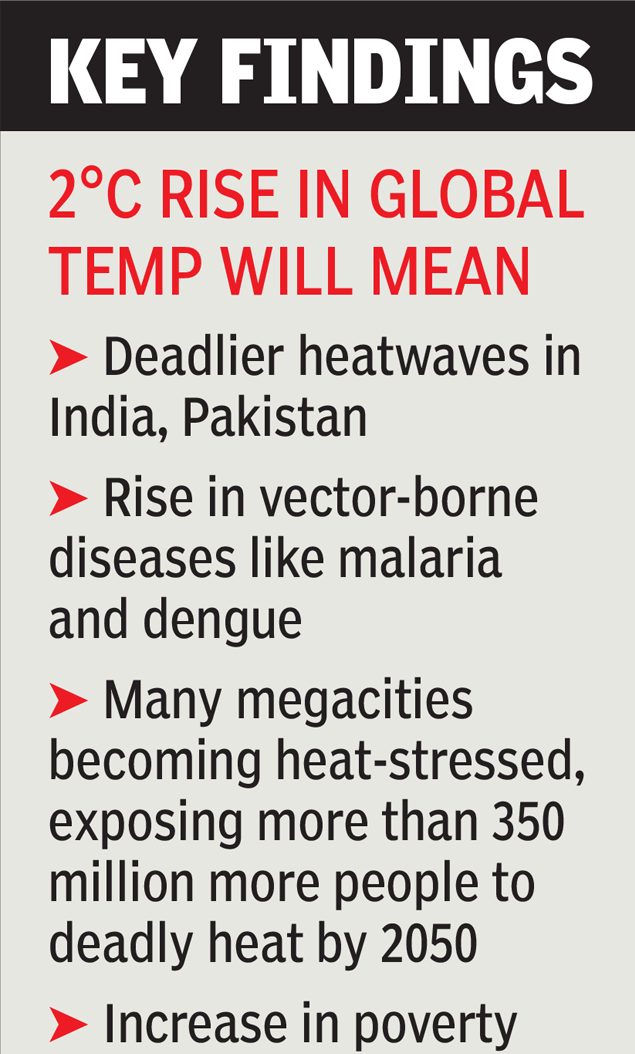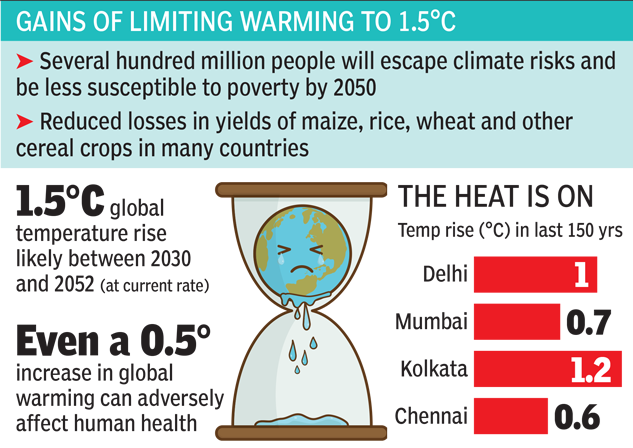

The Intergovernmental Panel on Climate Change (IPCC) has released a special report on the actions the world needs to take to prevent global average temperatures from rising beyond 1.5°C as compared to pre-industrial times.
Issue
Context
- The Intergovernmental Panel on Climate Change (IPCC) has released a special report on the actions the world needs to take to prevent global average temperatures from rising beyond 1.5°C as compared to pre-industrial times.
- The ‘Special Report on Global Warming of 1.5°C,’ compares the impact of global warming of 1.5 degree C and 2 degree C. It provides details on how the global response to climate change needs to be strengthened within the broader context of sustainable development and continuing efforts to eradicate poverty.
- The reportwill be a key scientific input for the Climate Change Conference in Poland in December 2018, when governments review the Paris Agreement to tackle climate change.
Background
- It was in 2015, at the Paris climate conference, that the global community made a pact to pursue efforts to limit warming to within 1.5°C — half a degree below the previous target of 2°C. With the increase in extreme events and the very survival of small islands at stake, the lower limit was greeted then with surprise and enthusiasm.
IPCC
- It is the international body for assessing the science related to climate change.
- It was set up in 1988 by the World Meteorological Organization (WMO) and United Nations Environment Programme (UNEP) to provide policymakers with regular assessments of the scientific basis of climate change, its impacts and future risks, and options for adaptation and mitigation.
- It assessments provide a scientific basis for governments at all levels to develop climate related policies, and they underlie negotiations at the UN Climate Conference – the United Nations Framework Convention on Climate Change (UNFCCC).
About:
Key Highlights of the Report
- At current rate of emissions, the world is set to breach the global warming limit of 1.5 degrees Celsius between 2030 and 2052. At present, the world is 1.2°C warmer compared to pre-industrial levels.
- Climate change could have “irreversible” and “catastrophic” impacts if the global average temperatures were allowed to rise beyond 2 degrees Celsius. Climate-related risks for natural and human systems are higher.
- There could be progressive worsening of extreme weather events as temperature rises.
- The report gave a more comprehensive assessment of the differences in a 1.5C world and 2C world and quantified the carbon dioxide that would need to be removed from the atmosphere to achieve this.
- The international effort to tackle climate change must be accelerated in order to limit global temperature rises.
- The report notes that investment in physical and social infrastructure is a key enabler in enhancing resilience and adaptive capacity.
- Poorly designed or implemented adaptation projects can increase greenhouse gas emissions and water use, increase gender and social inequality, undermine health conditions, and encroach on natural ecosystems.
- Hence, adaptation efforts must pay attention to poverty and sustainable development and these efforts need financial support.
- Adaptation needs have generally been supported by public sector sources, multilateral development banks, NGOs, private funding and UNFCCC channels.
- According to the report, there is a need to integrate Disaster risk management (DRM) and adaptation to reduce vulnerability. The report also identifies “educational adaptation” options which motivate adaptation through building awareness.
- A more participatory approach towards adaptation, especially for vulnerable population will be to formulate adaptation action based on indigenous knowledge. These people are threatened by cultural modification, dispossession of land rights and land grabbing, rapid environmental and social changes. Therefore recognition of indigenous rights, governance systems and laws is central to adaptation, mitigation and sustainable development.
- Involvement of local governments is important too since they enable more participative decision-making and involve wider community in designing and implementing adaptation policies.
Analysis
What is 1.5-degree C target?
- Since 1990s, countries started discussing climate change and began negotiating an international arrangement for tackling it together.The objective has been to limit rising global average temperatures to within 2°C from pre-industrial times
- Periodic Assessment Reports produced by IPCC, suggest that the impacts of climate change could be “irreversible” and “catastrophic” if the rise in temperature was allowed to go beyond the 2°C ceiling.
- Small island states and the least developed nations are likely to suffer the worst consequences of climate change. These countries negotiated that the goal should be to restrict the temperature rise within 1.5°C from pre-industrial times.
- A 1.5°C target demanded much deeper emission cuts from the big emitters, which in turn required massive deployment of financial and technological resources.
- The Paris Agreement ‘hold’ the increase in global average temperature to “well below” 2°C. It also promised to keep “pursuing efforts” to attain the 1.5°C target.
- Incidentally, the global average temperature has already risen by more than 1°C from pre-industrial times.At the current rate, the 1.5°C limit could be crossed as early as 2040.
How to attain the 1.5 degree target?
- The IPCC report suggests possible pathways to attain the 1.5°C objective.
- It would involve much sharper and quicker emission cuts by big emitters like China, the US, the European Union and India.
- These pathways are likely to be heavily dependent on the success of carbon removal technologies. However, no such technology exists yet but several possibilities are being explored.
Carbon Dioxide Removal (CDR)
- IPCC has presented four pathways through which the 1.5 degree target can be achieved.Each of these pathways is also dependent on some amount of Carbon Dioxide Removal (CDR).
- CDR is the physical removal of the stock of carbon dioxide from the atmosphere to reduce its concentrations. Technologies for CDR are still undeveloped and untested.
- According to the report, varying amounts between 100 to 1000 Gigatons of carbon dioxide would need to be removed from the atmosphere.
Why settling for 1.5 degree target?
- Research found that limiting global warming to 1.5°C could prevent around 3.3 million cases of dengue every year in Latin America and the Caribbean alone.
- According to World Bank report, additional 150 million people could be at risk from malaria if the temperature was allowed to increase beyond 2°C.
- The world could have 25 million fewer undernourished people by the end of the century, if the 1.5°C goal was achieved.
- 350 million additional people could be exposed to deadly heat waves if the warming increased to 2°C as compared to 1.5°C.
- A 1.5°C could prevent 153 million premature deaths due to air pollution by 2100, as compared to the 2°C scenario.
- A UNDP report in 2016 claimed that a 1.5°C strategy could create double the number of jobs in the energy sector by 2050. The world could be 3% wealthier by 2100 in a 1.5°C scenario compared to a 2°C scenario.
- Extreme weather events such as heavy rainfall and heat waves are likely to become more severe and frequent, and freshwater supply could fall sharply, in a 2°C world.
Impact on India
- According to the report, coastal nations and agricultural economies like India would be the worst affected.
- Decline in crop yields, unprecedented climate extremes and increased susceptibility could push poverty by several million by 2050.
- SunitaNarain, Director General, CSE in response to the report has remarked - “Even at a little over 1.0°C warming, India is being battered by the worst climate extremes – it is clear that the situation at 1.5°C is going to worsen. The new report from the IPCC has served us a final warning that we must get our act together — now and quickly,”
- India hadn’t made any scientific contribution — in terms of modelling possible climate change-impact to its agriculture, monsoon, urban dwellings — to this report but gave critical inputs to the scientific basis underlying these assessments.
Recommendations
- To limit ourselves to 1.5°C, global net anthropogenic CO2 emissions should reduce by about 45 per cent from 2010 levels by 2030, and should reach net-zero around 2050. Along with it, we also need serious cuts to non-CO2 emissions.
- Both methane and black carbon need to be reduced by 35 per cent or more of 2010 levels by 2050.
- Achieving these cuts requires rapid and “far-reaching transitions in energy, land, urban and infrastructure (including transport and buildings), and industrial systems”.It will also require political action and significant scale-up of investment.
- Average annual investment in low-carbon energy technologies and energy efficiency needs to scale up.
- Use of coal should reduce steeply and its share in electricity mix should be reduced to close to 0 per cent by 2050. There is a need for a significant fall in the share of oil in energy production by 2050.
- The industry sector will have to reduce emissions by around 75–90 per cent of 2010 levels by 2050.
- Real emission reductions can be achieved through a combination of new and existing technologies, including sustainable bio-based feedstocks, product substitution, and carbon capture, utilisation and storage (CCUS).
- In the land-use sector, some amount of pasture and non-pasture agricultural land for food and feed crops needs to be converted for energy crops.
Way Forward
- Limiting global warming to 1.5 degrees would require in all aspects of society.
- The IPCC report suggests that while meeting the 1.5°C warming goal is improbable, it is not impossible. Meeting the objectives of the Paris Agreement would inevitably have to involve carbon dioxide removal from the atmosphere.
- All pathways, which limit global warming to 1.5°C or allow a minimal breach, project the use of carbon dioxide removal (CDR) to the tune of 100–1000 GtCO2eq over this century.
- It implies that achieving the target purely by reducing emission is extremely improbable; investment will have to move towards active removal through afforestation, carbon capture and storage, and other novel technologies.
- The IPCC’s role is limited to bringing forth these options; it is now up to governments to decide on how to act.They can start by scaling up ambition on nationally determined contributions.
Learning Aid
Key Points: 

Practice Question
Q.“1. 5 degree C rise in temperatures will be catastrophic for coastal nations and agricultural economies like India.” Examine the given statement in the light of recently released IPCC Special Report on Global Warming of 1.5°C.
Approach:
- Introduce your answer by discussing about recently released IPCC report.
- Discuss about the challenges that rise in 1.5 degree C in global temperature will cause.
- Impact over India and coastal nations
- Conclusion

